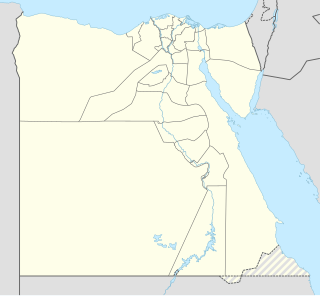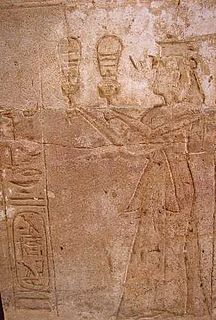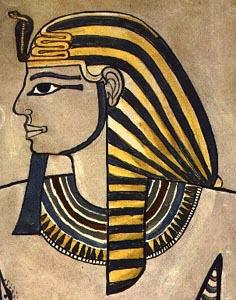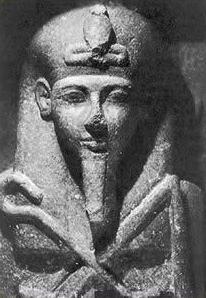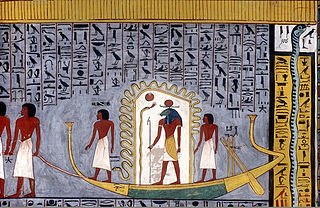The Ramesses IX Tomb-plan Ostracon is an Ancient Egyptian ostracon made of pale limestone. It is inscribed with a layout of the tomb of the Pharaoh Ramesses IX in the KV6 – Valley of the Kings, and dates from the 20th Dynasty (c. 1100 BC). The ostracon is inscribed on a sherd of approximate dimensions: 0.66m L (2/3 meter) by 0.2m W, and was found within his KV6 tomb.

Ancient Egypt was a civilization of ancient North Africa, concentrated along the lower reaches of the Nile River in the place that is now the country Egypt. Ancient Egyptian civilization followed prehistoric Egypt and coalesced around 3100 BC with the political unification of Upper and Lower Egypt under Menes. The history of ancient Egypt occurred as a series of stable kingdoms, separated by periods of relative instability known as Intermediate Periods: the Old Kingdom of the Early Bronze Age, the Middle Kingdom of the Middle Bronze Age and the New Kingdom of the Late Bronze Age.
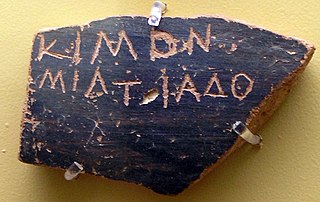
An ostracon is a piece of pottery, usually broken off from a vase or other earthenware vessel. In an archaeological or epigraphical context, ostraca refer to sherds or even small pieces of stone that have writing scratched into them. Usually these are considered to have been broken off before the writing was added; ancient people used the cheap, plentiful and durable broken pieces of pottery around them as convenient places to place writing for a wide variety of purposes, mostly very short inscriptions, but in some cases surprisingly long.

Limestone is a carbonate sedimentary rock that is often composed of the skeletal fragments of marine organisms such as coral, foraminifera, and molluscs. Its major materials are the minerals calcite and aragonite, which are different crystal forms of calcium carbonate (CaCO3). A closely related rock is dolomite, which contains a high percentage of the mineral dolomite, CaMg(CO3)2. In fact, in old USGS publications, dolomite was referred to as magnesian limestone, a term now reserved for magnesium-deficient dolomites or magnesium-rich limestones.
Contents
The 'blueprint-like' "tomb-plan" is not a draft plan of the tomb construction, but is a post-construction record. Notes in Hieratic name rooms, with dimensions. The composition of straight lines, (from a straightedge/device) use mostly 90 degree angles, but the design layout also conforms to the linear shape of the sherd, (thus requiring deviations from the 90 degree right angles).

A blueprint is a reproduction of a technical drawing using a contact print process on light-sensitive sheets. Introduced by Sir John Herschel in 1842, the process allowed rapid, and accurate, production of an unlimited number of copies. It was widely used for over a century for the reproduction of specification drawings used in construction and industry. The blueprint process was characterised by white lines on a blue background, a negative of the original. The process was not able to reproduce color or shades of grey.

Hieratic is a cursive writing system used for Ancient Egyptian, and the principal script used to write that language from its development in the 3rd millennium BCE until the rise of Demotic in the mid 1st millennium BCE. It was primarily written in ink with a reed pen on papyrus.
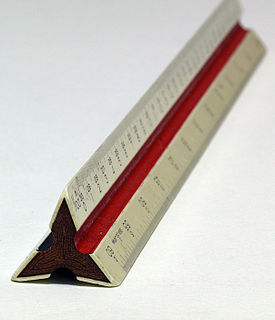
A straightedge or straight edge is a tool used for drawing straight lines, or checking their straightness. If it has equally spaced markings along its length, it is usually called a ruler.
As a linear sherd, the ostracon is broken into 4 contiguous pieces. As a dagger-shape, (non-rectangular), this is an atypical usage for ostraca, but the intention was probably durability, its resistance to decay and alteration, (the inks mostly). The sunken-relief (bas-relief) lines, are filled with black ink (some spillovers), and some minor inked regions are marked. The hieratic notes are also in black.

In Euclidean plane geometry, a rectangle is a quadrilateral with four right angles. It can also be defined as an equiangular quadrilateral, since equiangular means that all of its angles are equal. It can also be defined as a parallelogram containing a right angle. A rectangle with four sides of equal length is a square. The term oblong is occasionally used to refer to a non-square rectangle. A rectangle with vertices ABCD would be denoted as
The surviving design layout is about 90 percent complete due to loss of micro-chip edges, especially at the break points, and a few larger flakes.

